
And an experiment in scoring.
Having fallen in love with the taste of this loaf and avidly read all the accounts of the different experiences with this bake, I was ready to take another shot at it. Abe had suggested in passing that I try baking three loaves, each with different scoring.
Sure, why not?
I decided this time, too, to try doing the whole procedure from mix to bake in the same day, rather than overnight retarding.
Monday night
- fed my rye levain 1:2:2 for the first build
Tuesday morning
- built second stage of levain
Tuesday night
- built last stage of levain
- made soaker with pearl barley (this is a change), flax seeds, black sesame seeds (also a change) and pre-toasted multi-grain flakes
- measured out flours (note: the previous bake used wonderful, strong whole wheat bread flour from Abe. This time around, I used up the last 33g of the stuff and topped off the WW portion with T110, which is like first-clear flour) and whisked them together with the salt
Wednesday mid-morning
- measured out water, reserving 10% -- just in case
- mixed everything together, first using pincer and fold and gradually adding all the reserved water, then a few SLAFs.
- let the dough rest for 30 minutes and did a first set of folds
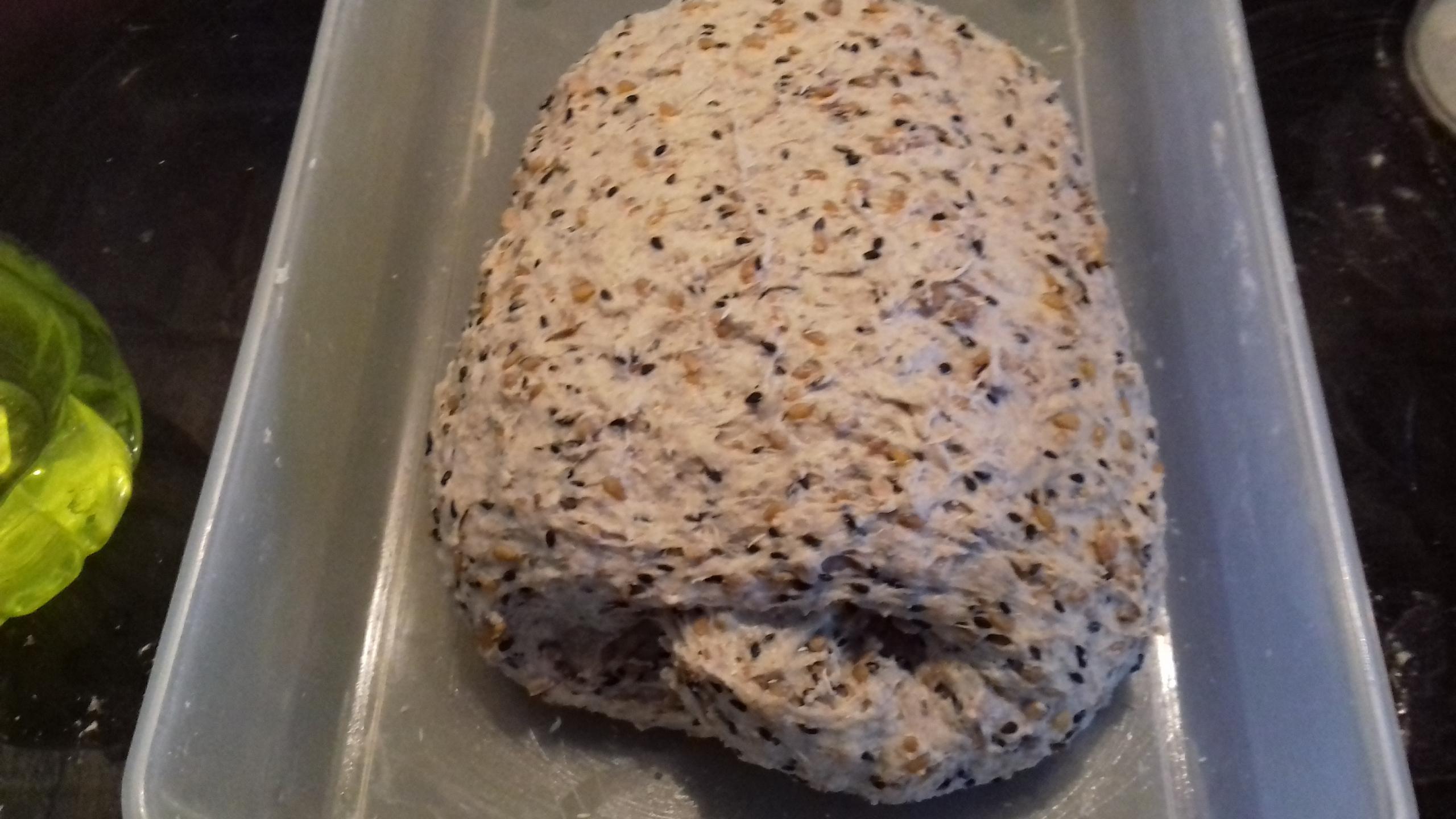
- after 45 minutes, was going to give a second set of folds, but it didn't seem necessary:
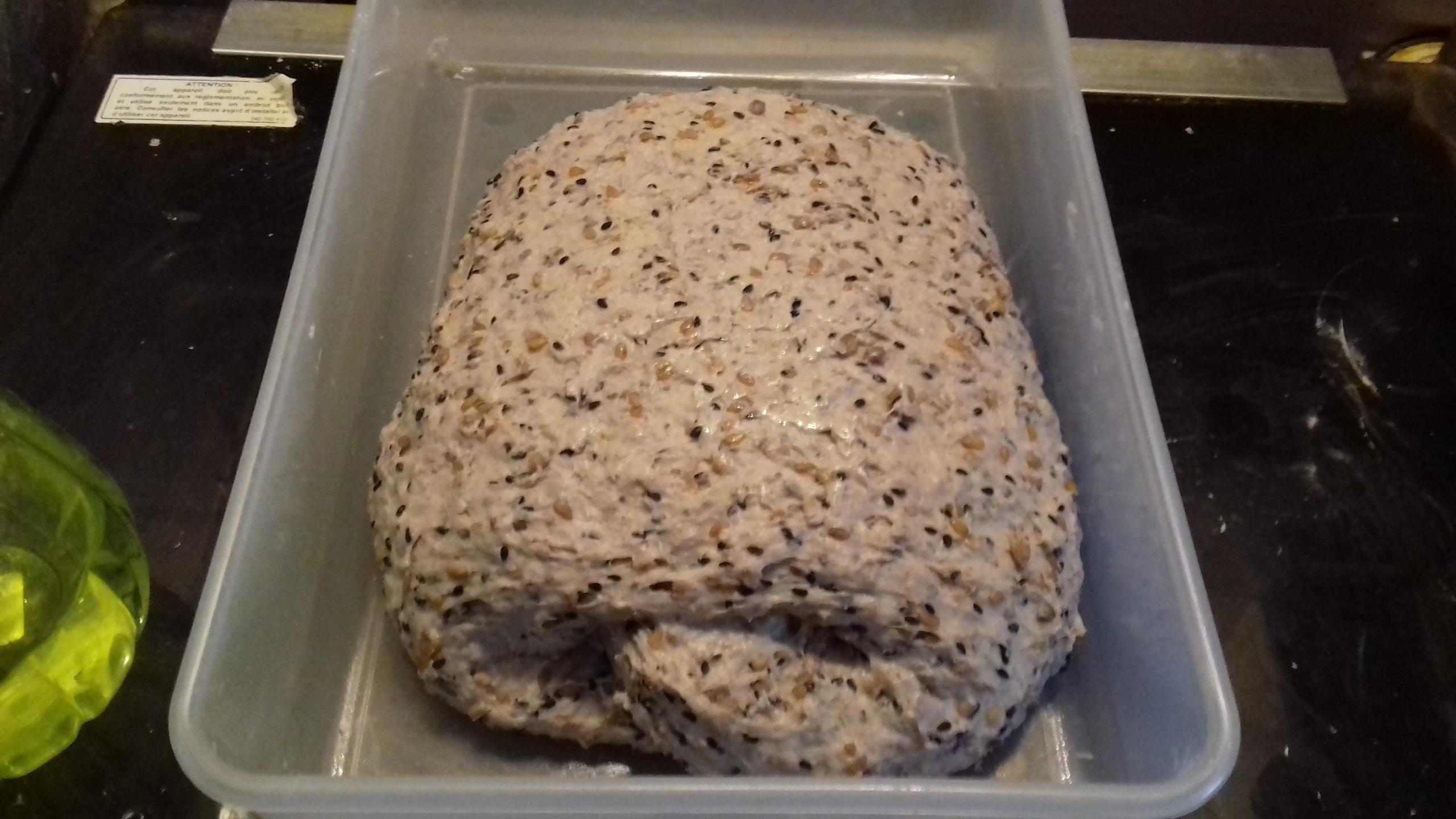
- I let it sit out for another half hour, then tucked it into the fridge while we went to the movies. When we got home, this is what it looked like, so I removed it from the fridge to warm up for a bit while dinner was put together, eaten and cleared.
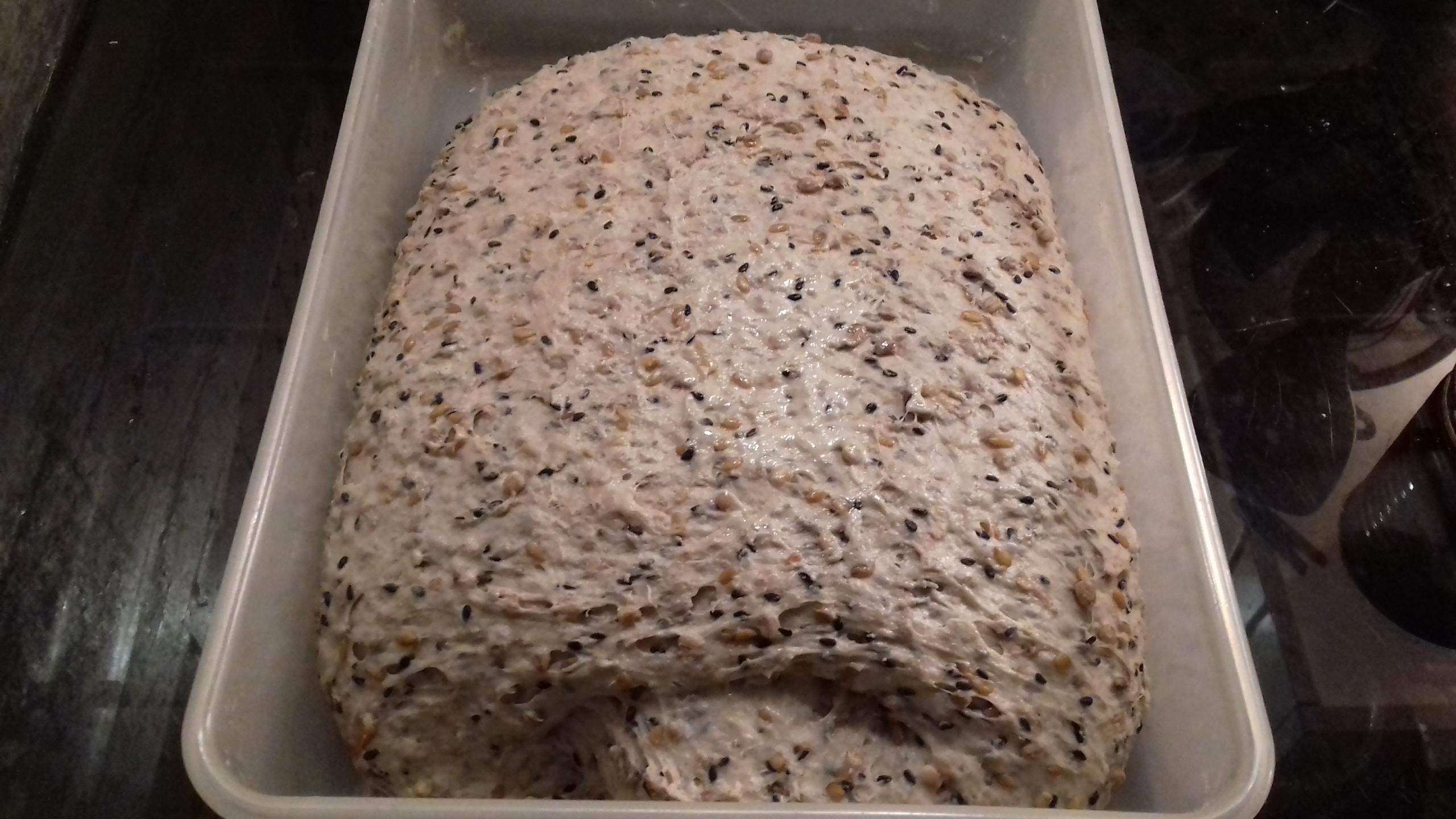
- weighed and divided the dough, remembering to stick a little into my little jar (lead photo). In all, there is a difference of 5g between the heaviest and lightest round of dough, in the neighborhood of 450g apiece.
- Bench rested about 40 minutes, then shaped into mini-batards and dipped in sesame seeds. Looks like a nursery, doesn't it?
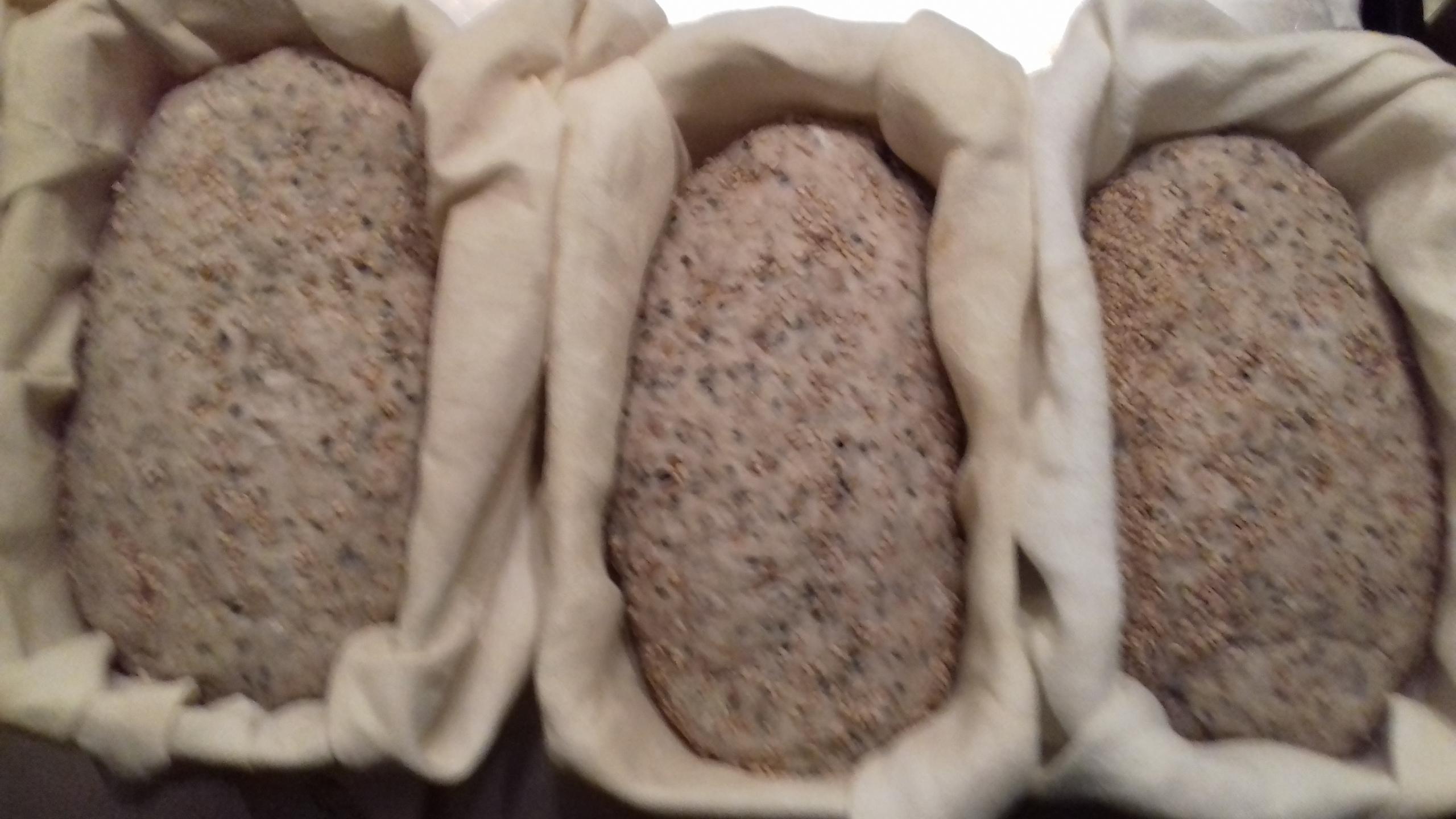
- Let rise for another hour or so and prehated the oven. The point of this exercise was to see the rise different types of scoring would yield, all other things being equal. Which meant baking them together. So here we are: a single score along the axis of the loaf, two diagonal scores and one unscored with the seam up
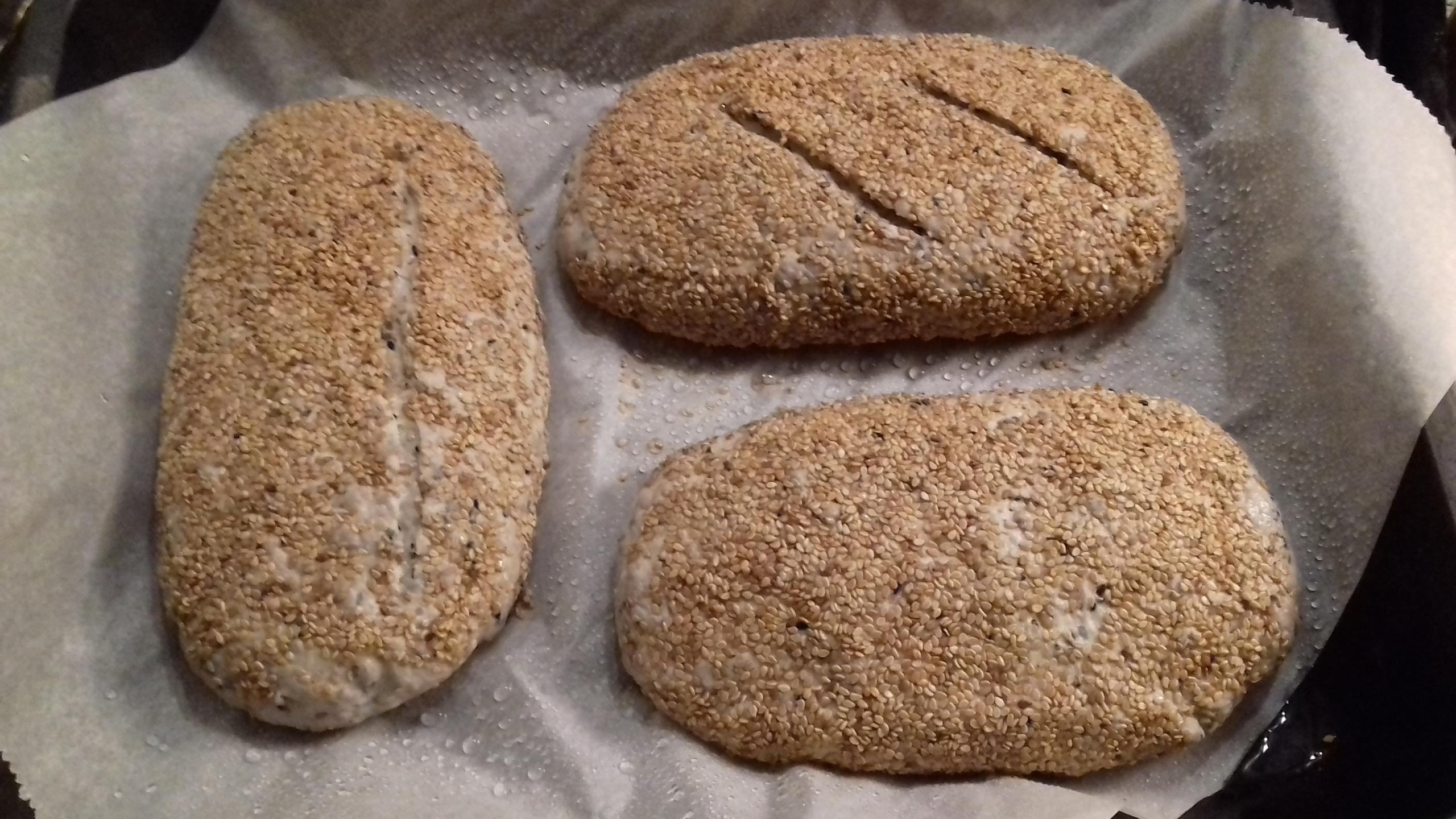
As you might be able to see, in the time that it took to place the other two loaves and score the top one, the single-score loaf had already begun to spread. So shaping needs further work to create more tension across the top of the loaf.
- Baked 25 minutes covered, 22 minutes uncovered.
Fresh out of the oven: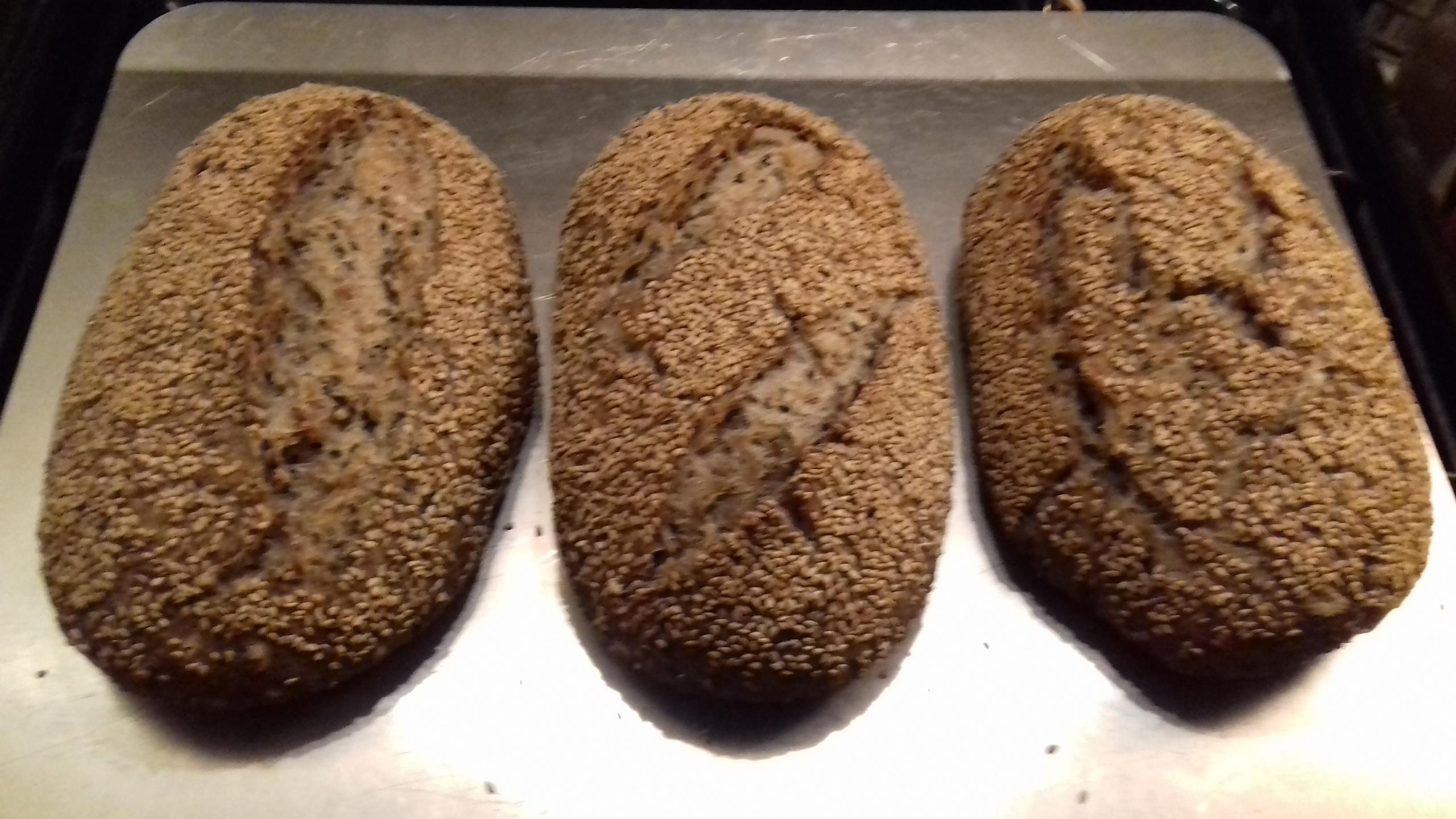
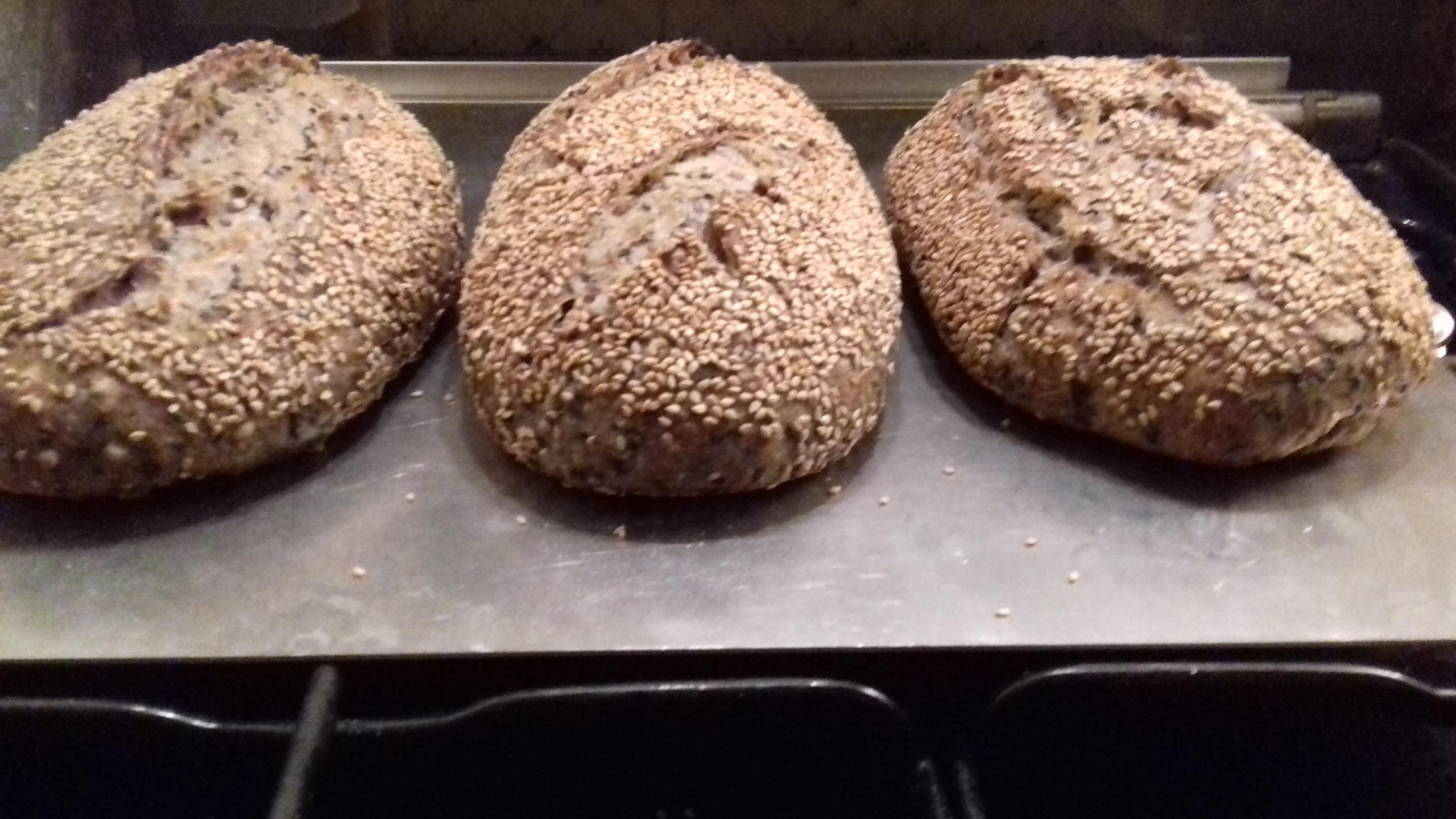
It's hard to tell from these bad photos, but the highest, roundest rise came from the double score, followed by the unscored one (far right). The single straight score definitely gave the lowest rise.
BTW, these were looking a little anemic, so they got popped back into the oven.
What is also interesting is that while they lost a bit of weight during baking (about 70g), the one that lost the least amount was the one in the middle.
Now all I need to do is work some more on the shaping to get nice, round slices like Danny!
Edit: Crumb shots
Two loaves were given away and I kept and cut into the unscored one:
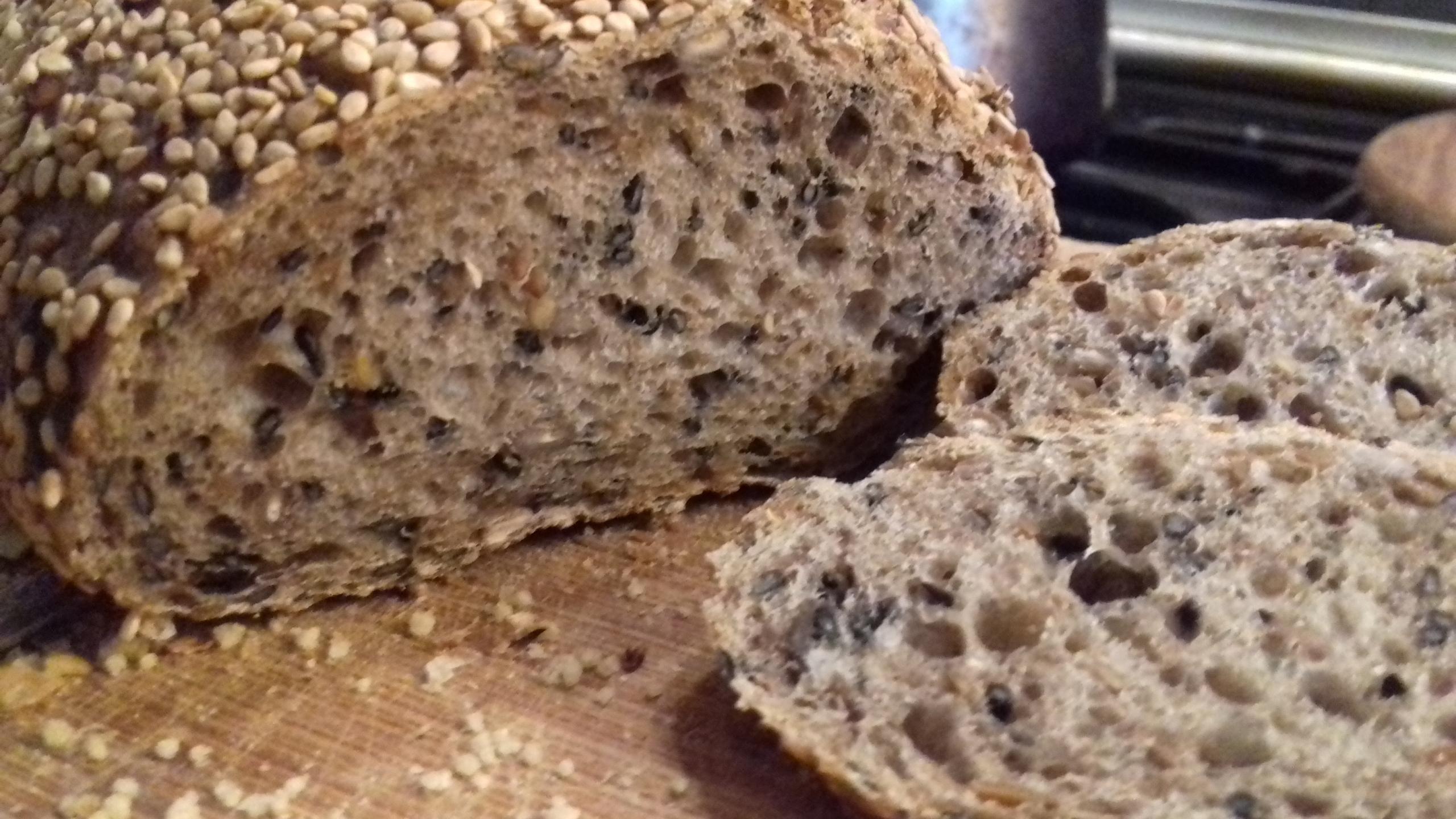
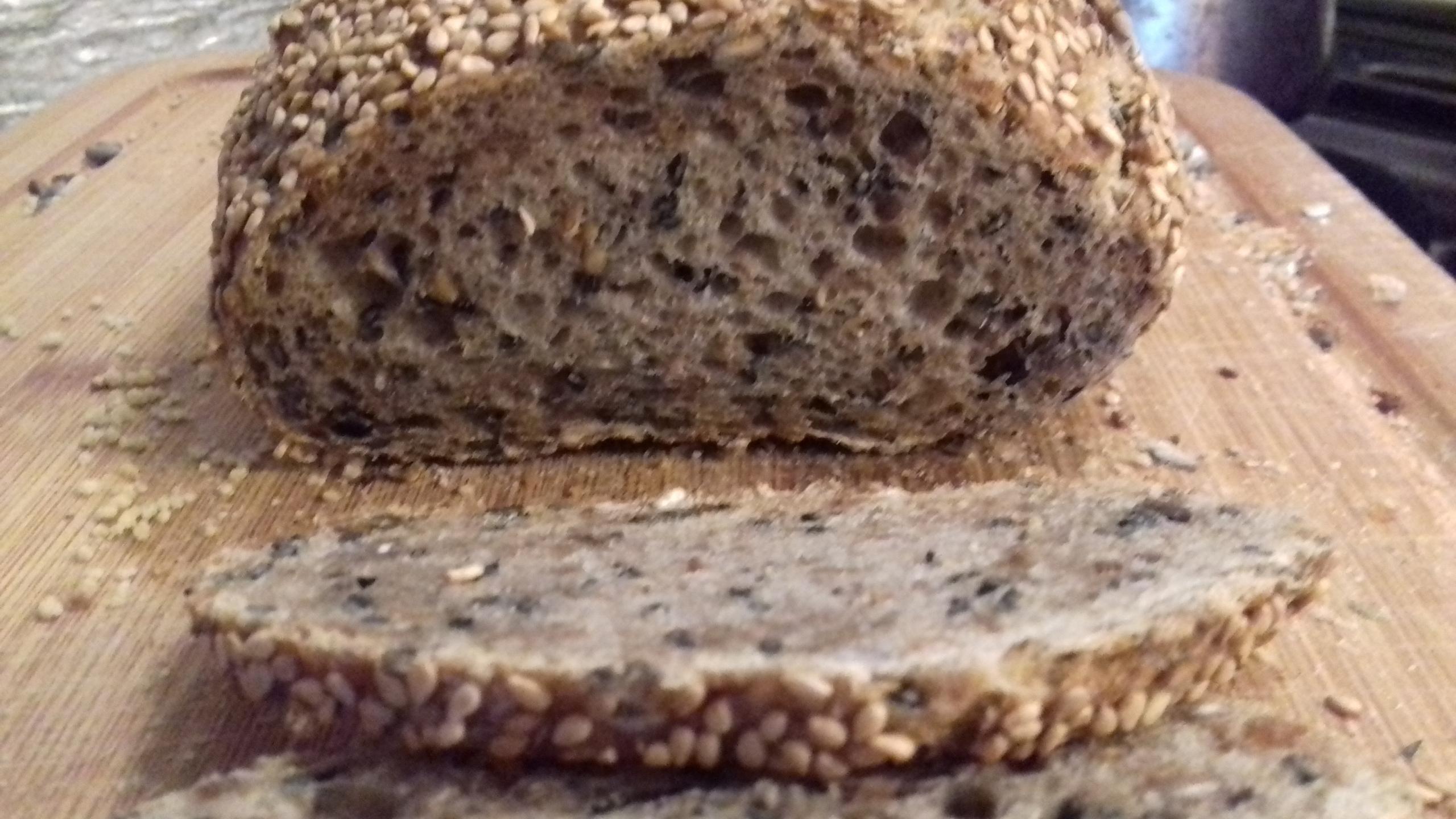
Fortunately, I like the taste and crumb on this one. Shortly after taking these snaps, got into an argument with my mandoline slicer and won't be slapping or stretching or folding for a couple of days!
- DesigningWoman's Blog
- Log in or register to post comments
Carole, if I was willing to venture a guess (and I am) I’d say the gluten could have been developed more. My suggestion would be to do more Slap & Folds with a rest in the middle. 200 reps would probably be good, 300 MIGHT be better.
Your doughs appear strong in the images, but looks may be deceiving. I think the add ins may drastically affect the appearance, making them appear strongly than they actually are.
Just a thought. I may or may not be correct.
Danny
I've been following your SLAF adventures, so I hear you. Thing is, I wondered whether or not the crumb from the first bake was because I'd slapped and folded too much, so this time just gave it about 50 slaps to make sure my mix was uniform, then resorted to pincering, stretching and folding.
Will try again next time, with lots of SLAFs to see what happens. But if I follow the hydration in the recipe, the dough really does feel more like clay than dough, which means I'll need to add water?
Abe, on the other hand, is suggesting that I cut down on the water to help get a tighter skin when I go to shape…
In any case, will have a few days to mull this over, since my right hand is still smarting from skidding on my faithful mandoline.
Keep on baking!
Carole
Almost all bakers for the Five-Grain wrote about adding water. A nice thing abou SLaF is that it is very easy to add water during the process. If you do hold out water, save the exact amount missing from the formula in a separate bowl. That way you can keep track of exactly how much water went into the formula. It may also serve to calculate extra salt.
I think 100% total water works very well. Alfanso agrees. The original formual calls for 98%
Btw - I thought your gluten in this bake needed to be stronger because of the way your crust separated. It seems to me that if the gluten was strong the crust would have opened better and not torn in the process. I assume you get steam to your loaves...
I also noticed the the center of your crumb looks very nice but the outer perimeters look a little dense. What temp did you bake at? If you used a vessel, was it preheated?
I am anxious to see your results.
Danny
Thanks for the quick response.
I typically hold back 10% of a recipe's water, since my flours aren't like American ones (I was working with 12% protein for the bread flour, 10% for the T110.). But I did indeed add back all of the water during the pincering/folding stage.
When you say 100% water, do you mean 100% of the water as written in the recipe?
And what's the hydration on this loaf, anyway? With the soaker, I couldn't figure it out.
Baked at 210° c in my improvised roaster (two same-sized roasting pans), which is 20° cooler than the first bake. That was a mistake. As a matter of fact, I even had to put them back into the oven, even though internal temp was 98°c.
So, once I'm back up to using my hand, we'll hope the third time's a charm!
Hanks for the thoughts.
Carole
I hopeyour hand heals quickly. The thought of a mandolin cut hurts to even think about. The formula as written calls for a total of 98% water. This includes both the dough and also the soaker water. I ended up adding an additional 2% water, bring the total water to 100% of the flour weight.
210C = 410F that is colder than what JH called for.
And it's more like multiple lacerations than a clean cut -- I was using the julienne blade. Stupid of me.
Will definitely up the water content on the next bake.
SLAFs, here I come (in a few days)!
Thanks Danny
Carole. I recommend following JH instruction closely. It worked for me. Do the soaker. Mix wet ingredients (including the soaker) then mix dry ingredients. Add all ingredients together, including the soaker at once and mix by hand (a deviation). Another possible deviation add 2% extra water. 2 sets of 150 SLaF with a rest in between. Bulk till 30-50% rise with a few letter folds. Retard over night. Score and bake cold until 207F or above.
That is what Alan told me and it worked very well.
Danny
I baked cooler than the first time: these were little loaves, about 450g, so I thought that I needed to bake at a lower temp than for the 700g loaves from last week. Mistake, huh?
About the dough structure, I'd up the hydration if I were you. I find that it's hard to work with stiff dough when there're some many seeds and grains in the dough. I'd worry about them cutting the gluten all the time... It might be easier to stretch the dough and build up structure when the dough becomes more extensible. Just a theory: not sure it'd work.
This is still unarguably soft and moist though. Nice bake, Carole!
I'll definitely try upping the water, SLAFs on this dough as written was like thumping a hunk of meat!
Fortunately, it does still taste really good!
Looking forward to your next bake and food spread!
Carole